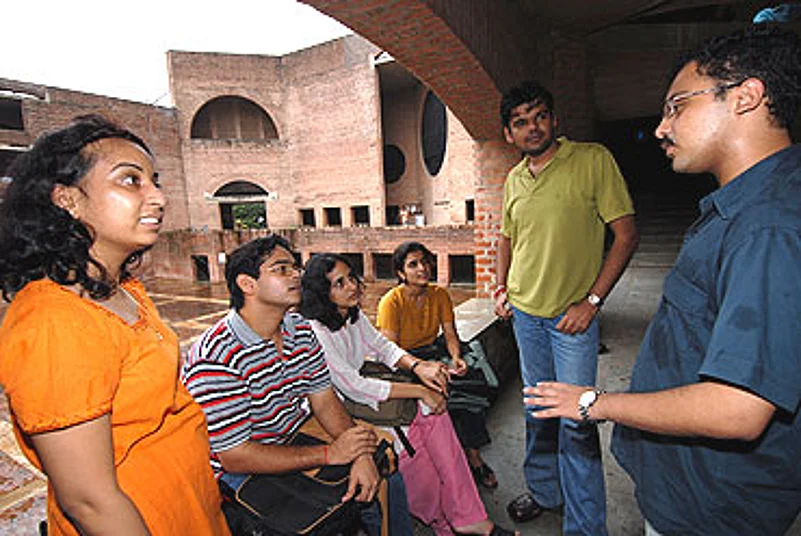Cost-To-Customer Ratio
- AIIMS, Delhi: Charges Rs 3,000 for the duration of the MBBS course. Fee has remained frozen for the last 10 years and is inclusive of hostel charges (mess fee is extra).
- St John’s Medical College, Bangalore: Rs 1.49 lakh per annum. Fees were Rs 15,000 till 2002-03. Hiked after a court directive allowed unaided colleges to hike fees.
- Indian Institutes of Technology: Rs 2 lakh for a four-year period spread over eight semesters. These fees were increased after a decade, when they were Rs 1.8 lakh.
- Jaypee Institute of IT: Fees are upwards of Rs 40,000 per annum, depending on the courses. There have been gradual fee hikes each year.
- Indian Institutes of Management: The recent fee hikes for the MBA programme range between Rs 2.5 lakh and Rs 7 lakh. Fees have been hiked periodically at the IIMs.
- SP Jain Institute of Management, Mumbai: Fee hiked to Rs 2.85 lakh per year for a two-year diploma in management, which is inclusive of hostel charges. Lastyear, it was Rs 2 lakh.
***
How times have changed. Such discussions on fee hikes were always punctuated with protests—usually leading to a well-established status quo. While unaided institutions were free to charge what they wanted, those enjoying government patronage had little freedom and fees remained where they were, even as other segments of education became prohibitively expensive. So, while a private institute charges anywhere above Rs 1 lakh per annum (after in some cases also demanding a capitation fee), government universities were always constrained by their commitment to providing "education for all", and to have a "reasonable" fee structure.
So, early last month, when IIM-Ahmedabad decided to increase fees for its two-year MBA course to Rs 11.5 lakh from Rs 4.5 lakh, anxious students (and parents who, one must add, actually bankroll the fee) waited with bated breath for other institutions to follow suit. And follow they did. IIM Calcutta has increased its fee, albeit not so sharply, from Rs 2 lakh to Rs 3 lakh for its MBA programme. Citing escalating costs and the fantastic salaries that post-graduates from their institutes stand to gain, Brand IIM suddenly decided to bite the fee hike bullet. IIM Calcutta director Shekhar Chaudhary had this to say: "If one factors in the money spent on each student, the facilities offered to them, the student loans from banks without furnishing collateral and, above all, the salaries they stand to get at the completion of their two-year course, the fee hike is justified." Considering that the IIMs invest close to Rs 5 lakh per student, the hike seems only fair.
And with the IIMs leading the way, could the Indian Institutes of Technology (IITs) be far behind? After remaining in deep freeze for over a decade, the premier institutes of learning doubled their annual tuition fees to Rs 50,000, from the earlier Rs 25,000 per annum. The National Institutes of Technology (NIT), 20 in all, will be taking stock next week. Chances are, they will go the IIT way too. Most of the directors Outlook spoke to say there would be no protests. But the debate is clearly under way at these institutes which were carved out of the regional engineering colleges. Says M. Chidambaram, NIT Tiruchirapalli director, "The cost of educating a student has to be factored in...one cannot wish away a fee hike. It’s important to note that the tuition fee is proportionate to the investment made on a student. Currently, the fee is Rs 12,000 per semester whereas if one looks at the infrastructure required to educate a single student, the state spends at least Rs 1 lakh."
These fees look minuscule when one factors in the jobs students get even before they complete their graduation. Chidambaram says his institute has 100 per cent placement success. With eight lakh students applying each year for the NITs and 15,000 making the mark, the fierce competition to get a berth is unrelenting. Also, as most directors point out, very few graduates stay on to engage in serious research after the completion of their degree. "Of the 400 students who are enrolled in our institute, not a single student goes for higher research. They all land jobs as soon as they finish graduation," says Chidambaram. He goes on to cautiously add that the proposed hike will be nothing compared to the fees charged by private engineering colleges in the state.
While everyone in charge of education is clear that a fee hike is inevitable, there are a few who feel a hike is undesirable, and also needless. At the country’s premier medical institute, the All Indian Institute of Medical Sciences (AIIMS), the tuition fee for a four-year MBBS course is Rs 3,000. In the nearby Maulana Azad Medical College, it is more or less the same with the student paying a little more as mess charges. Says Sunil Chibber, sub-dean, AIIMS, "With a Rs 480-crore budget grant from the government, there is no justification for a fee hike, especially when one considers the objectives—quality research, high academic standards and affordable patient care."
However, with a commitment to the same causes, St John’s Medical College, Bangalore, charges a fee of Rs 1.49 lakh each year. Says director, Fr Thomas Kalam, "We are still one of the few unaided institutions, so we have to charge this amount from our students. The college fee had remained at a staticRs 15,000 for 10 years till a hike was effected five years ago. A hike was required to maintain the standards set by the college. Some 6,000 vie for the 60 MBBS seats offered by the college."
To be sure, there are more arguments against raising fees: maintaining the status quo has been justified in the light of the government’s commitment to provide 26 per cent reservation to other backward classes. Indeed, at a larger level, fees have always generated debate and vociferous protests. At present, university fees vary, but, traditionally, they have been kept very low in government-funded institutes. In many cases, the fees do not even cover 5 per cent of the operating cost. There are many who argue that fee hikes do not add to anything much, and that it is the government that has to increase its allocation to higher education. Votaries of this standpoint feel that what is actually required is larger investment from the state, which has been carefully distancing itself from bankrolling higher education. This, they argue, leaves the door open for private players who have arbitrary fee structures that are out of reach for the common man.
But all agree that given the resource constraints within which governments at the Centre and the states work, they must either be able to subsidise education or will have to mobilise a reasonable amount by way of fees from those who can afford to pay. That’s the only way, the argument goes, a university can cover a reasonable part of the running cost. There is a view gaining ground that since most university students come from the top 10 per cent of the population (in terms of income level), they would be able to pay fees that amount to at least 20 per cent of the operating cost of general university education.

IIM Ahmedabad grads are unlikely to feel the fee hike pinch
In fact, a Planning Commission note on Higher Education (2007), said, "Most of the universities have in the past complained about chronic fund shortage which prevents them from spending on infrastructure, raising the standards of education, paying adequate salaries to the staff and generally improving the standards of higher education in the country.
So, the argument goes that if a student from a public school spends close to Rs 4,000 every quarter, is it therefore not logical to expect him to continue paying the same for higher education? Some schools that have come up in the metros even demand a hefty fee tag of Rs 7,000 per month. This stands in sharp contrast to the fees demanded by degree colleges funded by the government which attract a tuition fee of Rs 20 per month."
Also making a case for fee hikes in colleges, the Planning Commission paper argues that levels should be taken up to cover 20 per cent of a university’s operating costs—and that fees could be increased gradually in existing institutions and implemented immediately in new institutions. There will be many students who cannot afford to pay these fees, the paper argues, and they should receive scholarships. Obviously, the government will need to bankroll these additional scholarships. In fact, the Oversight Committee constituted in May last year had recommended an investment of Rs 17,27,022 crore over a period of five years in the light of the 27 per cent quota for OBCs. The Planning Commission also talks of a Rs 2,36,997-crore allocation for higher education, which is a fourfold increase from the 10th plan.
All these are big numbers, but then not all students need scholarships. While the debate rages over the need for a (marginal) fee hike, one thing is clear: educational institutions are crying out for it. Market forces, too, point in that direction. Whatever formula the government works out, it has to quickly decide on its goals for institutes that function under its thumb.


























